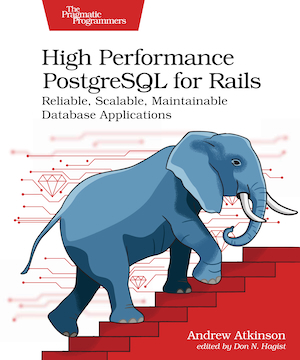- Introduction
- Q&A
- How do you optimize PostgreSQL for high performance in a Rails application?
- Can you share specific strategies for indexing tables to improve query performance?
- What database design considerations are crucial for achieving optimal performance with PostgreSQL in a Rails environment?
- Are there common pitfalls developers face when working with PostgreSQL in a high-performance Rails application?
- How do you handle large datasets efficiently, and what tools or techniques do you recommend for database maintenance in such scenarios?
- Could you discuss the impact of caching mechanisms on PostgreSQL performance, particularly in the context of a Rails application?
- What are some advanced features or settings in PostgreSQL that developers may not be fully leveraging for performance gains in a Rails project?
- How do you approach query optimization? Are there specific query patterns that developers should be mindful of for better performance?
- Can you share experiences or examples where database sharding or partitioning has significantly improved performance in a Rails application using PostgreSQL?
- Given the evolving landscape of PostgreSQL and Rails, are there any recent advancements or features that developers should be aware of to enhance performance?
- Wrap Up
- Links
Recently I met Kelvin Omereshone, based in Nigeria, for a session on his show Teach Kelvin Your Thing (TKYT). Here’s the description of the show:
Teach Kelvin Your Thing was created out of a need for me to learn not just new technologies but how folks who know these technologies use them.
Introduction
This was a fun opportunity to contribute to Kelvin’s catalog of more than 50 recorded sessions! The sessions mainly cover web development with JavaScript tech, until this one! Kelvin let me know this was the first TKYT session outside of JavaScript. Maybe we’ll inspire some people to try Ruby!
Besides TKYT, Kelvin is a prolific blogger, producer, writer, and an upcoming author! Kelvin is an experienced Sails framework programmer, and announced the recent honor of becoming the lead maintainer for the framework.
Kelvin and decided to talk about High Performance PostgreSQL for Rails.
The session is called High Performance PostgreSQL for Rails applications with Andrew Atkinson and is on YouTube. The recorded session is embedded below. Although we barely scratched the surface of the topic ideas Kelvin had, I’ve written up his questions as a bonus Q&A below the video. Note for the video: unfortunately my fancy microphone wasn’t used (by mistake). Apologies on the audio.
Q&A
With a one hour session, we only made it through some basics with the Active Record ORM, SQL queries, query planning, and efficient indexes. While those are some of the key ingredients to good performance, there’s much more.
The following questions explore more performance related topics beyond what we covered in the session.
How do you optimize PostgreSQL for high performance in a Rails application?
Achieving and sustaining high performance with web applications requires removing latency wherever possible in the request and response cycle. For the database portion, you’ll want to understand your SQL queries well, make sure they’re narrowly scoped, and that indexes are optimized to support them. Besides that, the physical server instances need appropriate sizes of CPU, memory, and disk.
While there are dozens of aspects to good performance, if I had to choose one for developers, I’d recommend focusing on writing efficient queries.
To write efficient queries, developers should spend time learning SQL, the query planner, and good indexing. They’ll need to understand their data model and the distribution of the data. While this is a lot to learn, these technologies are proven, and have longevity in the industry, so it’s a good investment of time to learn them well.
To get an overview of 5 major areas with Ruby on Rails and PostgreSQL to look at, check out my presentation: RailsConf 2022 - Puny to Powerful PostgreSQL Rails Apps by Andrew Atkinson.
Can you share specific strategies for indexing tables to improve query performance?
Indexes help remove latency when data is accessed. You’ll want to study your queries, learn how the query planner works, and use the query planner to confirm that indexes accesses are used efficiently.
What database design considerations are crucial for achieving optimal performance with PostgreSQL in a Rails environment?
Try to “Keep it simple.” Prefer “simple data types” over complex ones when possible, like integers over UUIDs. Have a sensible number of columns. Only add indexes when they’re needed by queries. Learn how to confirm which indexes are used and not used.
Try and use data types that are easily sortable, like numerical types.
Are there common pitfalls developers face when working with PostgreSQL in a high-performance Rails application?
Yes. Pitfalls in Rails might be remaining ignorant of the SQL queries that are generated by Active Record. When developers start asking questions about what high performance queries look like, and whether their specific queries are optimal, they’ll need to dive into their observability tooling. Once they know where to look, they can begin improving their slow queries, on their way towards better reliability, scalability, and cost efficiency.
How do you handle large datasets efficiently, and what tools or techniques do you recommend for database maintenance in such scenarios?
When working with large tables in PostgreSQL, for example 100GB or greater, consider using table partitioning. To use partitioned tables, you’ll need to migrate your table data into a new structure. Partitioned tables are child tables under a parent table, and the child tables are smaller and easier to work with. While this is a lot of work, the benefits for high growth, large tables, can be enormous.
For maintenance operations when working with large PostgreSQL databases, learn how Autovacuum works, the effects of bloat in tables and indexes, and how Autovacuum keeps tables optimized. From there, you’ll be in a position to tune Autovacuum so that Vacuum runs better, and you’ll know when to run commands like Analyze and Reindex as needed.
Could you discuss the impact of caching mechanisms on PostgreSQL performance, particularly in the context of a Rails application?
PostgreSQL has internal cache stores, but let’s discuss Ruby on Rails. Ruby on Rails has a variety of client cache layers. By using them, you can eliminate repetitive or unnecessary SQL queries entirely. The best way to learn about these caches is the Rails Guides documentation: https://guides.rubyonrails.org/caching_with_rails.html
What are some advanced features or settings in PostgreSQL that developers may not be fully leveraging for performance gains in a Rails project?
Developers may not be leveraging PostgreSQL Full Text Search (FTS), which is quite capable. With PostgreSQL handling search, you can spare your development team from having to run a second dedicated database. Or you may run a separate PostgreSQL instance for search, but you’ll be able to bring your operator skills and knowledge to support it.
PostgreSQL supports fuzzy searching to help you search text with various keywords, including misspellings. PostgreSQL also supports semantic (the “meaning”) search, with extensions like pgvector that fetch “embeddings” from Large Language Model API services. When users of your application submit searches, their text is embedded, and compared against stored embeddings, to find similar search based on it’s meaning. This is powerful!
Another advanced feature is PostgreSQL is native table partitioning. Partitioning helps when working with very large tables that are bogging down your operations. Partitioning helps enable an easy and efficient data archival process as well, and may even improve your query performance.
How do you approach query optimization? Are there specific query patterns that developers should be mindful of for better performance?
When working on reducing load on a server instance, take a wide view by studying the data from query observability tools like pg_stat_statements, and from application code using an APM.
Once you’ve got a specific query to optimize, try and add portions that reduce the data it’s accessing. Do that with additional filters, limits, or by reducing the fields. Once that’s taken care of, make sure the tables and indexes are free of excessive bloat. Make sure the indexes support the query efficiently. Squeeze everything you can from the instance. Sometimes you’ll need to flip things around and rewrite the query, or break pieces out using Subquery Expressions and Common Table Expressions (CTE).
Check out: PGSQL Phriday #008 — pg_stat_statements, PgHero, Query ID.
Can you share experiences or examples where database sharding or partitioning has significantly improved performance in a Rails application using PostgreSQL?
Yes. At my previous job, we isolated customer data into a dedicated database and instance. While this provided the greatest degree of isolation for both data and compute, it came with the trade-off of greater cost and complexity.
At the same job, we also used table partitioning to break up a very large table, to make it easier afterwards, when adding indexes or constraints, or working with row data replication. I turned our experience into a case study presentation called: Presenting ‘Partitioning Billions of Rows’ at SFPUG August 2023.
Given the evolving landscape of PostgreSQL and Rails, are there any recent advancements or features that developers should be aware of to enhance performance?
Both Ruby on Rails and PostgreSQL are mature technologies, that benefit from the contributions of thousands of programmers over decades. While there are fewer “earth shattering” features as a result, with this combination you can feel confident that you can start from scratch, and build to a massive scale.
PostgreSQL continues to release new features on an impressive annual release cadence. As core software, PostgreSQL must focus on reliability, durability, and resilience, when considering any new feature. PostgreSQL also focuses on excellent documentation and backwards compatibility.
In recent releases, Ruby on Rails expanded it’s support for working with Multiple Databases. When an application expands beyond a single PostgreSQL instance, Rails applications can take advantage of things like read and write splitting and horizontal sharding by using many instances, all connected and configure to their Rails app. Check out Multiple Databases with Active Record to learn more.
Active Record continues to fill out it’s native support for advanced database capabilities. Common Table Expressions (CTE) and Composite Primary Keys (CPK) were recently added. While they’re not new or performance related, support in the framework reflects the importance of these capabilities at large organizations, or apps with complex databases or queries.
Wrap Up
Thanks again Kelvin, for the opportunity to share!
Check out some links below based on the session or Q&A.
Links
- Rideshare app: https://github.com/andyatkinson/rideshare
- Ruby on Rails Documentary: https://www.youtube.com/watch?v=HDKUEXBF3B4
- Rails World conference: https://rubyonrails.org/world
- Rails World 2023 Recorded YouTube session playlist: https://www.youtube.com/playlist?list=PLHFP2OPUpCeY9IX3Ht727dwu5ZJ2BBbZP
- Learning PostgreSQL: https://www.postgresql.org/docs/online-resources/
- Caching in Rails: https://guides.rubyonrails.org/caching_with_rails.html

